|
|
 |
Fiche d'espèce de Copépode |
|
|
Cyclopoida ( Ordre ) |
|
|
|
Oncaeidae ( Famille ) |
|
|
|
Oncaea ( Genre ) |
|
|
| |
Oncaea cristata Böttger-Schnack, 2005 (F,M) | |
| | | | | | | Syn.: | Oncaea sp. M Böttger-Schnack, 1988; Oncaea ovalis : Böttger-Schnack, 1990; 1995 | | | | Ref.: | | | Böttger-Schnack, 2005 (p.167, figs.F,M; Rem.) | 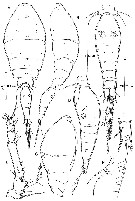 issued from : R. Böttger-Schnack in Cah. Biol. Mar., 2005, 46. [p.163, Fig.2]. Female (from Red Sea): A, habitus (dorsal); B, idem (lateralleft side); C, urosome (dorsal); D, idem (lateral right side); E, A1 (comb-like seta on segment 2 figured separately, aesthetasc on segment 4 not well discerned, stippled); F, caudal ramus (dorsal); G, specimen showing expanded prosome (lateral); H, P5 (dorsal). Nota: Proportional lengths (%) of urosomites and caudal rami 9.4:48.1:11.0:8.5:12.3:10.7.
Relative lengths (%) of segments of A1 measured along posterior non-setigerous margin 8.2:14.3:49.0:11.8:5.3:11.4. Anal somite 1.3 times wider than long, slightly longer than caudal rami. caudal ramus about 1.5 times longer than wide.
|
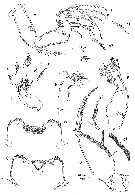 issued from : R. Böttger-Schnack in Cah. Biol. Mar., 2005, 46. [p.170, Fig.3]. Female: A, A2 (lateral elements are numbered using Roman numerals, distal elements are identified by capital letters [a1, distal part of element B; a2, distal part of element III); B, labrum (anterior); C, idem (posterior); D, Md (showing individual elements); E, Mx1; F, Mx2; G, Mxp (anterior) [g1, inner margin of basis, posterior; g2, distal element on basis, posterior, showing ornamentation].
|
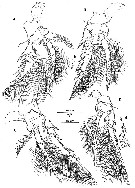 issued from : R. Böttger-Schnack in Cah. Biol. Mar., 2005, 46. [p.171, Fig.4]. Female: A, P1 (posterior); B, P2 (posterior) [b, lateral margin of exop-3, showing pore between outer subdistal and outer distal spine, spines not figured); C, P3 (posterior); D, P4 (anterior) [d, outer margin of exop-3, arrow indicating pore between outer subdistal and outer distal spine).
|
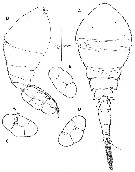 issued from : R. Böttger-Schnack in Cah. Biol. Mar., 2005, 46. [p.174, Fig.5]. Female (from Gulf of Aqaba): A, habitus (dorsal, showing expanded prosome and slight variation in form of genital double-somite); B, ovigerous female (lateral right side, caudal setae partly omitted) [b, egg-sac of same specimen, dorsal]; C, detached egg-sac (provisionally assigned to O. cristata), inner view, showing egg-sac string (arrowed); D, idem (outer view).
|
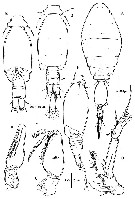 issued from : R. Böttger-Schnack in Cah. Biol. Mar., 2005, 46. [p.175, Fig.6]. Male (from Red Sea): A, habitus (dorsal); B, A1 (comb-like seta on segment 2 figured separately, arrow indicating proximal small aesthetasc); C, Mxp (anterior, proximal part of endopodal claw, showing fused pectinate spine [c, medial view, claw not figured); D, urosome (dorsal, dislocated pore on anal somite arrowed); idem (ventral); F, idem (lateral left side). Nota: Proportional lengths (%) of urosomites and caudal rami 8.6:56.8:4.0:4.0:3.6:11.1:11.9. Relative lengths (%) of segments of A1 measured along posterior non-setigerous margin 5.4:16.2:51.4:27.0.
|
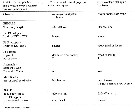 issued from : R. Böttger-Schnack in Cah. Biol. Mar., 2005, 46. [p.204, Table 3]. Major morphological characters separating the 2 species groups recognized within the ovalis-complex of Oncaeidae.
| | | | | NZ: | 1 | | |
|
Carte de distribution de Oncaea cristata par zones géographiques
|
| | | | Loc: | | | Gulf of Aqaba, Red Sea | | | | N: | 1 | | | | Lg.: | | | (933) F: 0,42-0,46; M: 0,38-0,40; {F: 0,42-0,46; M: 0,38-0,40} | | | | Rem.: | Sibling species of Oncaea crypta.
Voir aussi les remarques en anglais | | | Dernière mise à jour : 26/01/2015 | |
|
|
 Toute utilisation de ce site pour une publication sera mentionnée avec la référence suivante : Toute utilisation de ce site pour une publication sera mentionnée avec la référence suivante :
Razouls C., Desreumaux N., Kouwenberg J. et de Bovée F., 2005-2025. - Biodiversité des Copépodes planctoniques marins (morphologie, répartition géographique et données biologiques). Sorbonne Université, CNRS. Disponible sur http://copepodes.obs-banyuls.fr [Accédé le 31 octobre 2025] © copyright 2005-2025 Sorbonne Université, CNRS
|
|
 |
 |









